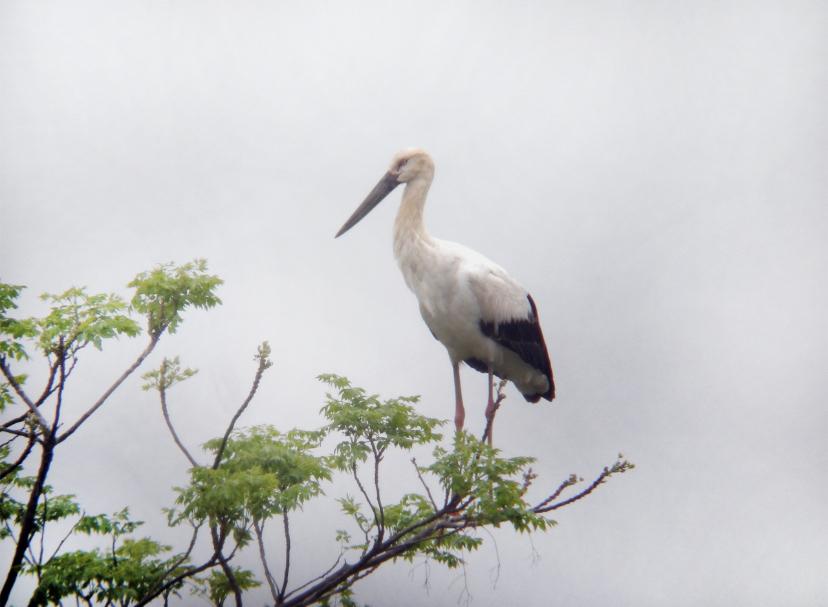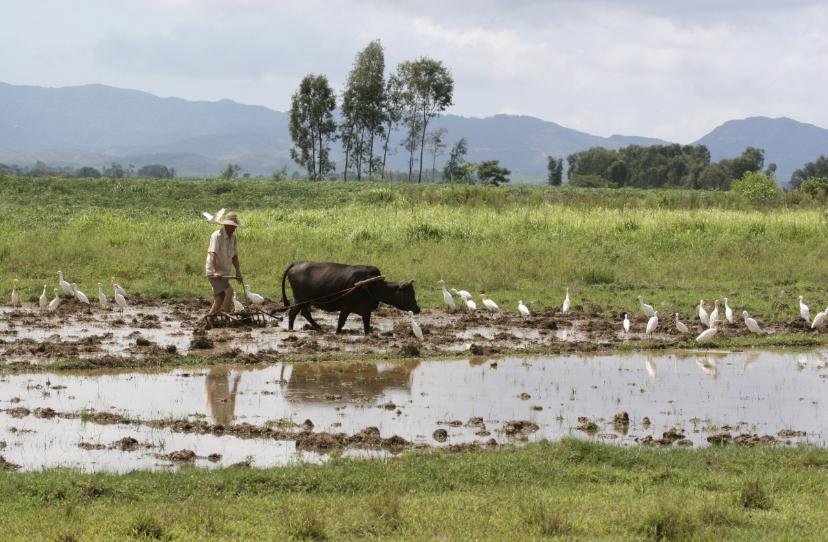
In recent days, a flock of over 170 oriental storks, a nationally protected wild animal species, was spotted in the Haifeng Bird Nature Reserve in Guangdong. This is the second time since January 2023 that more than a hundred oriental storks have been discovered in Shanwei since the recording of 179 oriental storks in Lufeng County.

The oriental stork is a large wading bird belonging to the Ciconiidae family. It inhabits open marshes, lakes, and wet grasslands, primarily feeding on fish, frogs, reptiles, insects, and small rodents. With a global population of fewer than 4,000, it is classified as China's nationally protected wild animal species. As a migratory bird, the oriental stork is primarily found in Northeast China, Inner Mongolia, Japan, North Korea, and other regions during the summer. During winter, they migrate to Eastern and Southern China, with significant concentrations in places such as Poyang Lake in Jiangxi and Yangzhou in Jiangsu.

It is reported that the first observation of oriental storks in Guangdong dates back to the 1990s, with records in Zhuhai. In recent years, oriental storks have been continuously sighted in various locations in Guangdong, including Guangzhou, Shenzhen, Dongguan, Jiangmen, and Maoming. For example, in the Nansha Wetland in Guangzhou, up to 49 oriental storks have been observed together. The Songshan Lake in Dongguan has recorded over 40 oriental storks resting and foraging. Recently, 17 oriental storks were recorded in Maoming, Guangdong.

Zhang Qiang, Deputy Director of the Institute of Zoology, Guangdong Academy of Sciences, mentioned that the environmental quality of habitats and the abundance of food resources can influence the choice of waterbird migration sites. The appearance of a flock of oriental storks in Guangdong is important evidence of the province's persistent efforts in wildlife and habitat conservation, intensified wetland protection, as well as the continuous improvement of the ecological environment.
As an important pathway for global bird migration, Guangdong welcomes a large number of wintering migratory birds from November to March each year. According to statistics, Guangdong has a historical record of 584 wild bird species, including 412 migratory bird species, accounting for 70.5% of the total. Among them are 23 nationally protected wild animal species, such as the Chinese merganser, black-faced spoonbill, snow crane, and oriental storks. Over the years, Guangdong has implemented multiple measures to enhance the protection and restoration of important nodes along the migration routes, with an aim to improve the network for migratory bird conservation.

According to the Forestry Administration of Guangdong Province, there has been a significant increase in the number of new records and newly discovered species of migratory birds in Guangdong. The populations of wild bird species have gradually recovered and grown. For instance, the populations of black-faced spoonbill and spoon-billed sandpiper wintering in Guangdong have shown an upward trend year by year.
Source :Yangcheng Evening News
170余只!珍稀濒危鸟类东方白鹳成群现身广东汕尾
日前,170余只国家一级保护野生动物东方白鹳成群出现在广东海丰鸟类省级自然保护区,这是汕尾自2023年1月在陆丰县记录到179只东方白鹳以来,第二次监测到百只以上的东方白鹳。
东方白鹳是鹳形目鹳科的大型涉禽,栖息于开阔的沼泽、湖泊和潮湿草地,主要捕食鱼类、蛙类、爬行类动物和昆虫,也捕食小型啮齿类动物,全球种群数量少于4000只,是国家一级保护野生动物。东方白鹳为冬候鸟,夏天主要分布在我国东北、内蒙古以及日本、朝鲜等地,冬天迁徙到华东、华南区域,主要集中在江西鄱阳湖、江苏扬州等地。
据悉,广东首次观测到东方白鹳是在上个世纪90年代,曾在珠海有记录。近年来,东方白鹳持续在广东广州、深圳、东莞、江门、茂名等多地露面,如广州南沙湿地最多曾观测到49只东方白鹳“同框”;东莞松山湖曾记录到40余只东方白鹳休憩觅食;广东茂名日前记录到17只。
广东省科学院动物研究所副所长张强表示,栖息地的环境质量、食物资源的丰富程度会在一定程度上影响水鸟迁徙地点的选择,东方白鹳成群现身广东,是广东省持之以恒保护野生动物及其栖息地、加大湿地湿地保护力度,促进生态环境持续向好的重要展现。
广东是全球候鸟迁飞的重要通道,在每年11月至次年3月都会迎来大批越冬候鸟。据统计,广东全省历史记录有野生鸟类584种,其中具有迁徙属性鸟类412种,占70.5%,包括中华秋沙鸭、黑脸琵鹭、白鹤、东方白鹳等23种国家一级保护野生动物。长期以来,广东围绕迁徙候鸟保护,多措并举加大对省内候鸟迁徙路线重要节点的保护和修复,推动完善候鸟保护网络。
据省林业局透露,近年来广东省迁徙鸟类的新纪录、新分布种类大幅度增加,野生鸟类种群数量逐步恢复并增长,如黑脸琵鹭和勺嘴鹬在广东越冬的种群数量呈逐年上升趋势。
文 | 记者 王彤 通讯员 林荫
译 | 陈萱
-
Simachong in Guangzhou welcomes a major transformation
2024-01-08 23:10:06 -
Dingjin embroidery from Huadu makes a debut at Shenzhen International Fashion Festival
2024-01-08 23:10:06 -
Guangdong adds 15 forest chief-guarded green parks
2024-01-07 23:17:06 -
Rare Hainan Eld's deer calves make debut at Guangzhou Chimelong
2024-01-07 23:17:06






